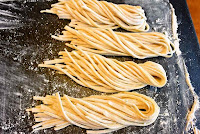1/2 recipe (average to large 1-person portion):
385 calories; 10.5 g protein; 2.8 g fat; 75.2 g carbohydrate; 73.1 g net carbs; 14 mg sodium (basically 0 mg after boiling); 3 mg cholesterol; 2.1 g fiber
Whole recipe:
770 calories; 21.1 g protein; 5.5 g fat; 150.4 g carbohydrate; 146.2 g net carbs; 28 mg sodium (basically 0 mg after boiling); 6 mg cholesterol; 4.2 g fiber
<Ingredients>
70 g flour
50 cc water
130 g flour
50 cc (51 g milk)
Extra flour and potato starch (or corn starch, tapioca starch) for rolling out dough (not in photo)
<Directions>
1.
Make yudane water roux.
Boil water (microwave for 30 seconds), swirl into (70 g) flour, and quickly mix with spatula.
When mixture temperature is manageable, switch to hand, and knead until smooth.
Cover, and let sit in fridge overnight (or several hours at room temperature).
2.
Remove water roux from fridge and bring to room temperature.
Cut into smaller pieces, and mix with (130 g) flour.
Bring milk to room temperature (or microwave for 10+ seconds if cold).
Swirl in water roux + flour mixture, and quickly mix, aiming to incorporate all flour with moist components.
The mixture is still crumbly at this point.
3.
Cover, and let sit for 5+ minutes to help moisture blend with flour.
(This process is effective as a jump start of the next process, but can be skipped.)
4.
Place dough in large durable plastic bag (or sandwich between 2 plastic sheets).
Without closing bag, place on towel on floor, and step repeatedly on bag to flatten/knead dough.
Tread again.
Repeat 10 times, a total of 20-30 minutes.
Fold dough into three one last time, close bag, and let sit at room temperature for 60-90 minutes (or in fridge for 4+ hours)
5.
Sprinkle flour and potato starch, and roll out dough into rectangle.
Avoid pressing folded corners.
Cut into desired width (noodles will be 20% or so wider when boiled).
When dough is soft, cut strands tend to stick to each other during cutting. If this happens, unfold strands and sprinkle potato starch, shake off excess, and set aside.
With remaining dough, sprinkling more potato starch on top surface can help somewhat.
Udon is ready to boil.
(Udon can be frozen at this point.)
6.
Bring plenty of water to boil.
Once boiling, put udon, and cook for 7-8 minutes (or until desired softness is achieved), first at high heat to return to boil after adding noodles, then reduce heat to medium low.
Stir occasionally to prevent noodles from sticking to the bottom.
Transfer to a bowl with lots of water, and chill.
Rub udon surface with both hands, and rinse several times until water is clear.
<Notes>
- Instead of treading on dough, you can knead it using your hands. As dough contains a relatively small amount of moisture, kneading requires lots of muscle. After dough is flattened, you can jump, step, or do pirouettes on the dough ... any stepping action helps formation of gluten for chewiness.
- The last process of chilling with cold water tightens the texture of udon. For this reason, when checking noodles while boiling, immerse one noodle in cold water, and then test. Boiling time varies by noodle thickness.
- Instead of milk, (additive-free) soy milk or water works fine, too. Finished noodles taste richer with milk, followed by soy milk and water in this order. Using milk for water roux is also possible and results in a richer taste. But the dough becomes somewhat hard to manage (probably because of my limited experience).
- Sodium in noodles will be released into boiling water, and virtually 0 mg sodium remains in boiled noodles, according to measurement at my kitchen.
- For the water roux making above, I followed advice on kako's bread blog (in Japanese) on how long to leave water roux in the fridge (6-24 hours) and proportions of ingredients (by weight, boiling water should be up to 70-75% of the flour when making water roux).
- For me, letting water roux sit in the fridge for 10+ hours seems to work great.
- When using frozen teuchi udon, boil without defrosting (photo at right).
- I use unbleached all-purpose flour. It adds a tint to finished noodles. This flour is likely to contain much more protein than flour commonly used for udon in Japan


























No comments:
Post a Comment